Market Overview
The Global Wireless Display Market size is projected to reach USD 6.4 billion in 2025 and grow at compound annual growth rate of 12.5% from there until 2034 to reach a value of USD 18.5 billion.
Wireless Display (WiDi) technology allows screens like TVs, monitors, or projectors to show content from devices such as smartphones, tablets, or laptops, without using any cables. It works by transmitting audio and video signals over Wi-Fi, Bluetooth, or similar protocols. Instead of plugging in an HDMI cable, users can mirror or stream content wirelessly. This is especially useful in homes, offices, classrooms, and public venues where fewer wires make things more convenient and cleaner.
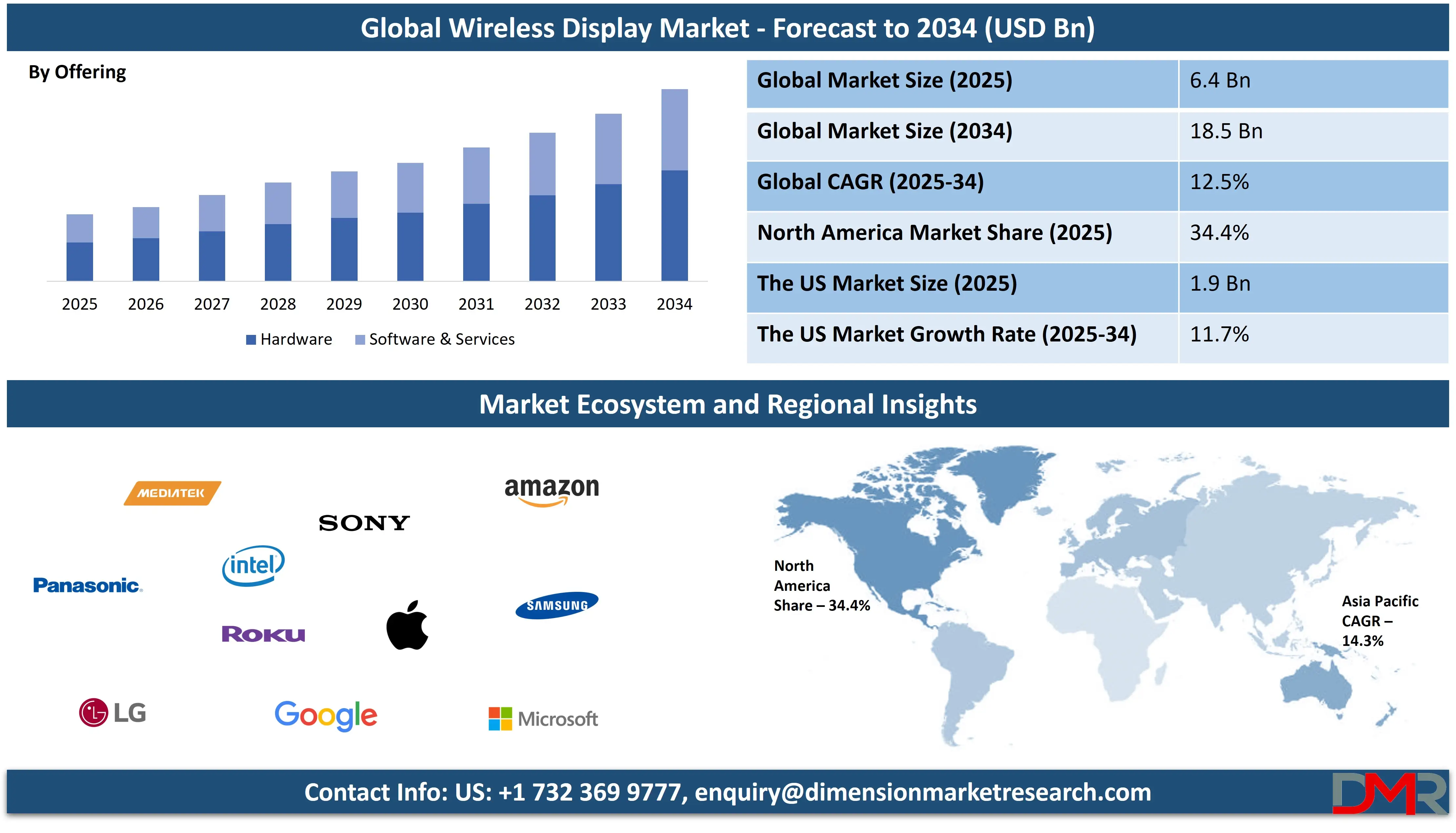
The Wireless Display Market is expanding as industries increasingly rely on tools that enhance smart connectivity and screen mirroring solutions. Over the past few years, the demand for wireless display technology has grown rapidly.
One big reason is the increasing number of people working from home and attending virtual meetings. With more video conferencing, screen sharing, and online classes, users need a fast and simple way to connect screens. In education and business settings, wireless display tools help share presentations and lessons quickly. At the same time, people at home are using it more to stream movies or play games from their phones or computers to larger screens.
Trends in wireless display include more integration with smart TVs, smart home systems, and collaboration tools. Devices today are built with WiDi support already included, such as Chromecast, Miracast, AirPlay, and others. These tools are now standard in many laptops, smartphones, and smart TVs. Another growing trend is the support for high-quality video—4K and even 8K—with minimal delay or lag, which improves both entertainment and professional experiences. Technologies such as Display Driver Integrated Circuit are also playing a crucial role in advancing performance and reducing latency in display devices.
In recent years, several events have influenced this space. Tech giants like Google, Apple, Microsoft, and Amazon have improved their wireless display technologies, leading to wider adoption. The release of new devices that support better wireless connectivity, such as Wi-Fi 6 and now Wi-Fi 7, has also made wireless display faster and more reliable. Moreover, newer office solutions such as Microsoft Teams Rooms and Zoom Rooms include wireless display features by default.
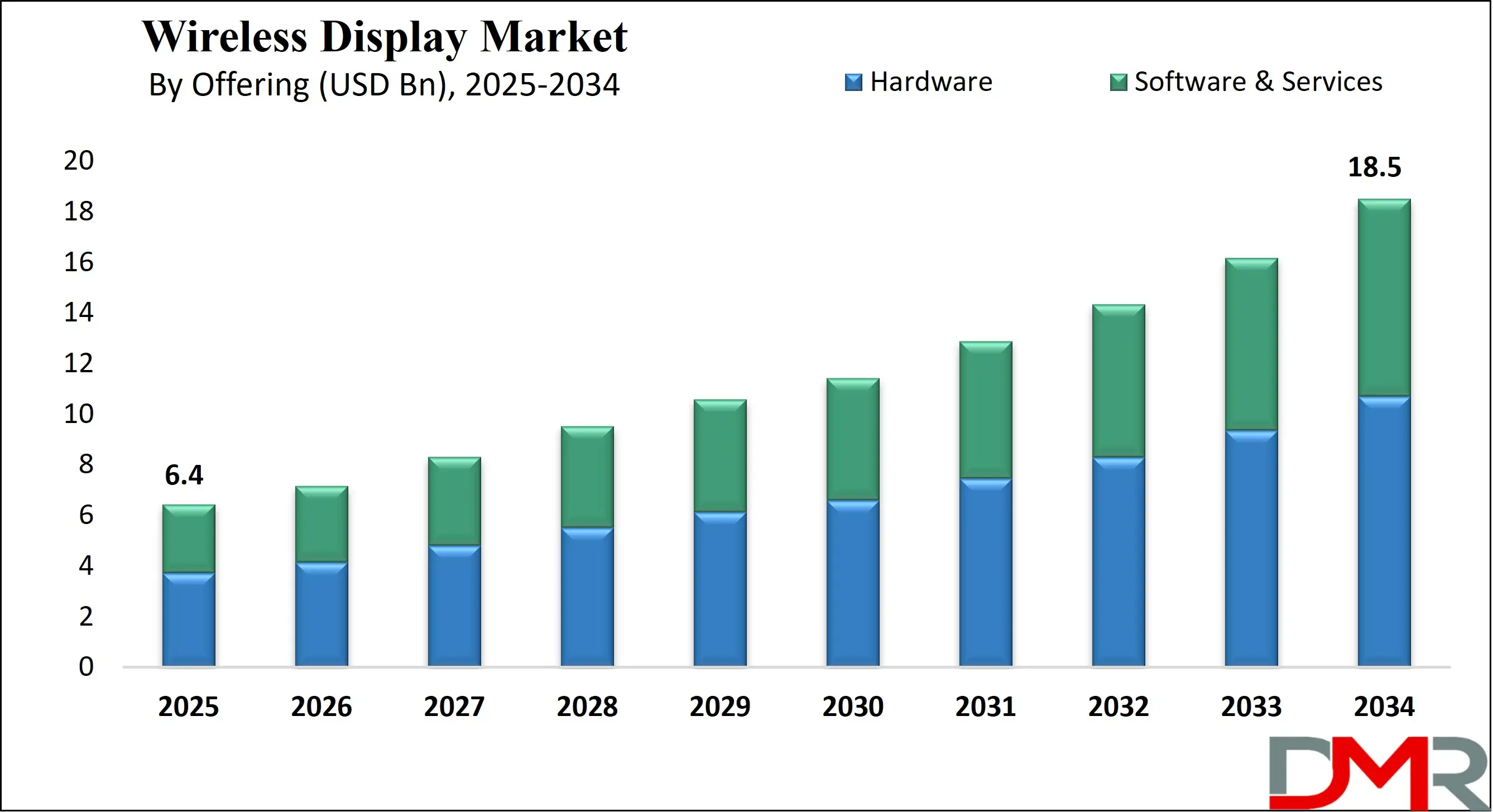
A major insight is that wireless display is no longer a luxury—it is becoming a must-have. It improves flexibility, allows for more open and interactive communication, and simplifies everyday screen sharing. Whether for entertainment or productivity, it eliminates the mess of cables and improves the user experience. It also plays a growing role in remote and hybrid work models, aligning with broader digital tools like Digital Adoption Platform that help organizations drive technology efficiency.
The US Wireless Display Market
The US Wireless Display Market size is projected to reach USD 1.9 billion in 2025 at a compound annual growth rate of 11.7% over its forecast period.
The US plays a major role in the wireless display market due to its advanced technology ecosystem, strong consumer base, and early adoption of digital solutions. Many major tech companies based in the US drive innovation by developing new wireless display technologies and integrating them into smart devices.
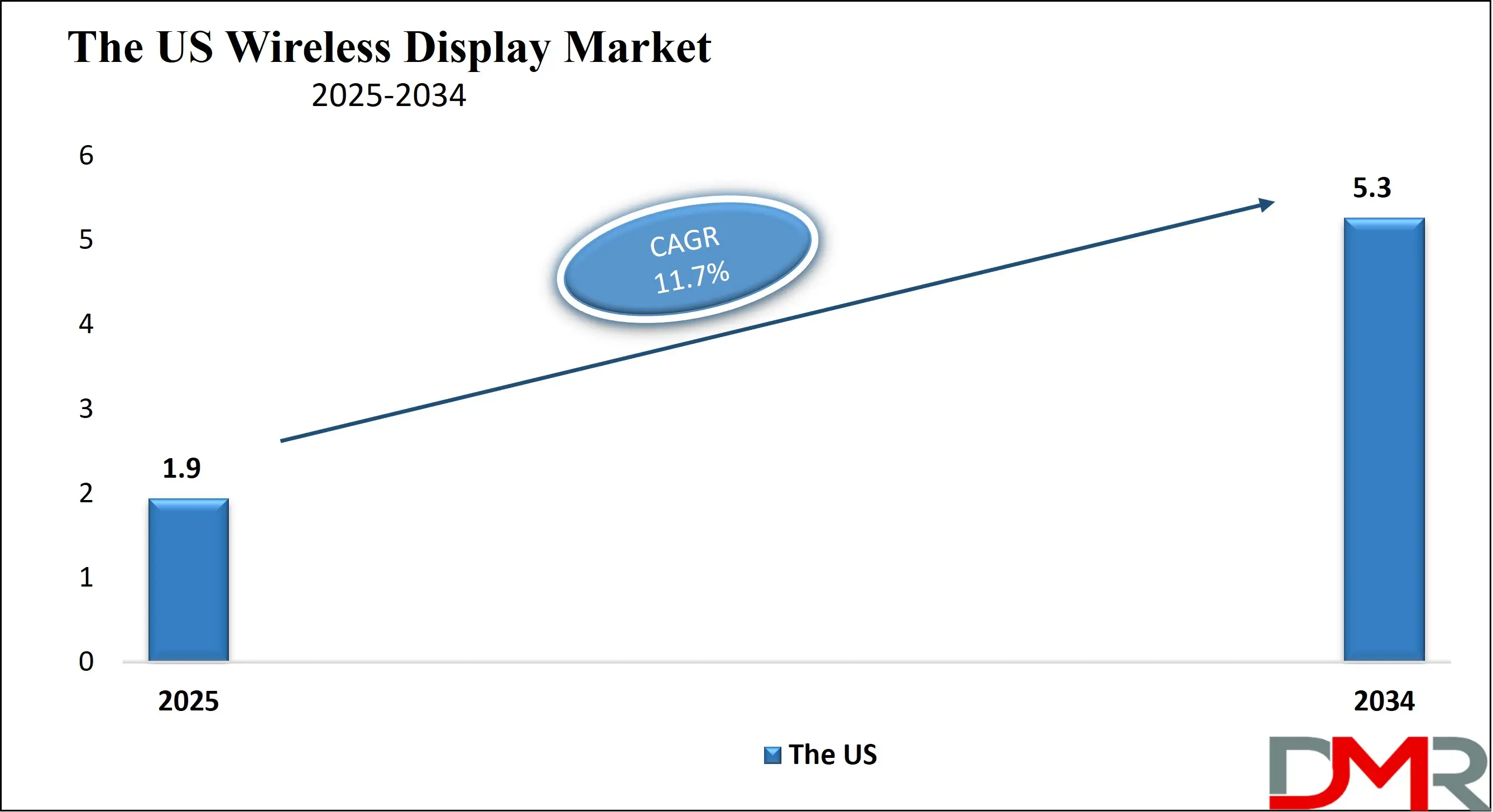
The country also has a high demand for remote work tools, home entertainment systems, and connected learning environments, all of which boost market growth. In addition, the US supports ongoing research in wireless communication standards like Wi-Fi and 5G, which directly impact the performance of wireless display solutions. With strong infrastructure and a focus on digital convenience, the US continues to be a leading force in shaping the direction of this market.
Europe Wireless Display Market
Europe Wireless Display Market size is projected to reach USD 1.4 billion in 2025 at a compound annual growth rate of 12.3% over its forecast period.
Europe plays an important role in the Wireless Display Market by promoting innovation, digital transformation, and sustainability across industries. The region has a strong demand for wireless technologies in smart homes, education, healthcare, and business settings. Governments and private sectors in Europe actively invest in smart infrastructure and digital classrooms, which supports the adoption of wireless display systems.
European consumers also value convenience and energy-efficient solutions, encouraging the use of wireless and cable-free technologies. Many European tech firms collaborate with global players to develop cross-platform display solutions and ensure compliance with strict data privacy standards. With growing interest in seamless communication tools, and complementary technologies such as Digital Map solutions, Europe continues to support steady growth and development in the wireless display ecosystem.
Japan Wireless Display Market
Japan Wireless Display Market size is projected to reach USD 320 million in 2025 at a compound annual growth rate of 12.1% over its forecast period.
Japan plays an important role in the wireless display market through its focus on innovation, advanced electronics, and strong consumer demand for high-quality technology. The country is home to many leading tech manufacturers that continuously improve display hardware and wireless communication systems.
Japan's early adoption of smart home devices and advanced digital tools in education and business helps drive growth in wireless display usage. Its entertainment, gaming, and media sectors also rely heavily on seamless, high-definition display solutions, and further boosting demand. Additionally, Japan’s commitment to digital transformation and initiatives in smart living environments encourage wider integration of wireless display technologies. With a culture that values efficiency and convenience, Japan remains a strong influencer in the development of this market globally.
Wireless Display Market: Key Takeaways
- Market Growth: The Wireless Display Market size is expected to grow by USD 11.4 billion, at a CAGR of 12.5%, during the forecasted period of 2026 to 2034.
- By Offering: The hardware are anticipated to get the majority share of the Wireless Display Market in 2025.
- By End User: The Residential segment is expected to get the largest revenue share in 2025 in the Wireless Display Market.
- Regional Insight: North America is expected to hold a 34.4% share of revenue in the Global Wireless Display Market in 2025.
- Use Cases: Some of the use cases of Wireless Display include home entertainment, business meetings, and more.
Wireless Display Market: Use Cases
- Home Entertainment: Wireless display lets users stream movies, TV shows, or games from their phones or laptops to big screens without cables. This makes it easy to enjoy high-quality video and audio from anywhere in the room. It also allows seamless switching between devices for a better viewing experience.
- Business Meetings: In offices, wireless display helps share presentations, documents, and charts instantly during meetings. Team members can connect their devices to a central screen without needing HDMI or VGA cords. This speeds up collaboration and reduces setup time.
- Education and Training: Teachers and trainers use wireless display to project lessons, videos, and interactive content onto classroom screens. It helps make learning more engaging and allows students to share their work with the class. It also supports hybrid teaching methods.
- Gaming and Casting: Gamers can use wireless display to mirror mobile or PC games onto larger screens with minimal lag. It offers a more immersive gaming experience without the clutter of wires. It’s also useful for live streaming or watching game replays.
Stats & Facts
- As per Uswitch
- In 2022, 86% of people accessed the internet using their mobile phones, a dramatic increase from just 28% in 2009, showing how mobile has overtaken other devices as the main gateway to the online world.
- Almost all UK adults aged 16 to 24—approximately 98%—now own a smartphone, reflecting how deeply integrated mobile technology is in the lives of younger generations.
- Around 39% of people in the UK use their mobile phones for gaming, underlining the growing popularity of smartphones as a go-to entertainment platform.
- Between 2021 and 2022, there was a 9.2% decline in the number of minutes spent making traditional phone calls, suggesting a shift toward digital communication methods like messaging and video calls.
- As of March 2022, the UK had over 83 million active mobile subscriptions, which highlights the country’s widespread access to mobile services, even surpassing the total population.
- Two in five people regularly play games on their mobile devices, showing how mobile gaming is now a mainstream habit rather than a niche activity.
- One in 20 UK adults with a mobile phone plays Candy Crush Saga, proving that casual games still hold a strong grip on daily mobile usage.
- As of 2023, half of all nine-year-olds in the UK own a smartphone, a sign of how early digital access begins and the growing role of mobile devices in children’s lives.
- In 2022, about 32.1% of mobile users in the UK reported being very satisfied with their network provider, indicating a moderate level of customer contentment, though not universal.
- A survey conducted in September 2022 revealed that 38% of people upgrade their phones every two years, reflecting a steady refresh cycle driven by contract plans and new features.
Market Dynamic
Driving Factors in the Wireless Display Market
Rising Demand for Remote Work and Hybrid Collaboration
The shift toward remote work and hybrid office setups has significantly increased the need for flexible, wireless communication tools. Businesses and professionals now rely on smooth screen-sharing and video conferencing to stay connected and productive. Wireless display technology allows teams to share presentations, spreadsheets, and video calls instantly without needing physical cables or adapters.
This saves time and helps keep meeting spaces clean and organized. The ease of connecting different devices like laptops, tablets, and smartphones to large screens or projectors wirelessly supports better collaboration. As more companies adopt hybrid work models, the demand for reliable wireless display tools continues to rise. These solutions are now becoming a standard part of modern conference rooms and shared workspaces.
Growing Popularity of Smart Devices and Connected Living
The rapid growth of smart TVs, smartphones, tablets, and other connected devices is driving the need for seamless content sharing. Consumers want easy ways to stream movies, music, games, and personal media from one device to another without using physical cables. Wireless display enables this experience by allowing content from a small screen to be mirrored onto a larger screen in seconds.
It also supports high-quality video and audio, making it ideal for home entertainment setups. As more households adopt smart home technologies, the demand for integrated and wireless solutions is growing. Users now expect compatibility across devices and platforms, making wireless display a key feature in modern electronics and smart living environments.
Restraints in the Wireless Display Market
Compatibility and Connectivity Issues:
One major restraint in the wireless display market is the lack of consistent compatibility across devices and platforms. Not all smartphones, laptops, TVs, or operating systems support the same wireless display standards like Miracast, AirPlay, or Chromecast. This creates confusion for users and limits seamless connectivity. In some cases, users may need to install additional apps or buy adapters, which adds to the cost and reduces convenience.
Furthermore, software updates can sometimes break compatibility or cause performance issues. These problems can lead to frustration, especially in professional or educational environments where reliable connections are essential. As a result, inconsistent performance and limited device support can slow down market adoption among users seeking a plug-and-play experience.
Security and Privacy Concerns
Another key challenge for the wireless display market is ensuring secure and private data transmission. Since wireless display involves broadcasting content over Wi-Fi or similar networks, there is always a risk of unauthorized access, eavesdropping, or data leaks. This is particularly concerning in corporate or government environments where sensitive information may be shared on-screen.
If the connection is not encrypted or properly secured, it may expose systems to cyber threats. Additionally, some users may hesitate to use wireless display solutions in public places due to concerns about privacy. Without strong security protocols and user-friendly privacy controls, organizations may prefer traditional wired solutions, limiting broader market adoption.
Opportunities in the Wireless Display Market
Integration with Emerging Technologies and Smart Environments
The wireless display market has strong opportunities through integration with emerging technologies such as IoT, smart homes, and AI-powered systems. As more homes and workplaces become connected, there is a growing need for devices that can interact seamlessly without cables.
Wireless display can serve as a central tool for sharing content across smart TVs, home assistants, and connected appliances. In offices, it can work alongside smart whiteboards, digital signage, and remote conferencing tools. This opens the door for manufacturers to design all-in-one display systems with advanced features like voice control, gesture recognition, and multi-user collaboration. As smart environments continue to grow, wireless display will play a vital role in creating a more unified and efficient user experience.
Expansion in Education and Healthcare Sectors
There is a major opportunity for wireless display solutions in education and healthcare, where fast and clear content sharing is essential. In schools, wireless display can help teachers present interactive lessons, share multimedia content, and involve students in real-time. It eliminates the need for complex setups, allowing educators to focus more on teaching than on tech support. In healthcare, wireless displays can be used to show patient reports, imaging scans, or training videos in a safe and hands-free manner.
This is especially helpful in environments where physical movement or infection control is a concern. As these sectors continue to modernize, wireless display systems can offer flexible, efficient, and hygienic solutions to meet their evolving needs.
Trends in the Wireless Display Market
Integration with Smart Environments and Voice Control
Wireless display is rapidly becoming a key part of connected homes and workplaces. It now often comes built into smart TVs, tablets, and assistants, enabling users to cast content through voice commands or app shortcuts. AI-powered features help with auto detection, content optimization, and quick pairing—all without cables. This seamless integration enhances convenience and encourages more people to adopt wireless display technology in their daily routines.
Push for High-Resolution, Low-Latency Experiences
Users increasingly expect 4K and even 8K visuals with minimal lag—whether for gaming, streaming, or presentations. To meet this demand, the market is moving toward faster wireless standards like Wi‑Fi 6 and 5G, as well as advanced codecs like HEVC and AV1. These improvements deliver smooth, high‑definition streams and set the stage for future AR/VR and ultra-connected experiences.
Impact of Artificial Intelligence in Wireless Display Market
Artificial Intelligence is significantly influencing the wireless display market by enhancing connectivity, optimizing content delivery, and improving user experience. AI-powered technologies enable seamless screen sharing, adaptive resolution adjustment, and intelligent bandwidth management, allowing displays to function smoothly across various devices and network conditions.
These smart systems can detect the type of content being streamed—whether it's video, presentation, or gaming—and automatically adjust frame rates, brightness, and resolution for optimal performance. This results in reduced latency, clearer visuals, and more efficient power usage. AI also assists in troubleshooting connectivity issues in real time, providing users with a more stable and responsive wireless display experience.
Beyond performance optimization, AI is driving innovation in personalization and multi-device collaboration. Wireless display solutions now incorporate features like voice recognition, gesture control, and predictive user interfaces, allowing for hands-free operation and intuitive interaction. In sectors such as education, business, and entertainment, AI helps tailor content delivery to audience preferences, increasing engagement and effectiveness.
For example, in smart classrooms or remote meetings, AI can automatically highlight speakers, filter background noise, or adjust visuals to enhance clarity and focus. Moreover, AI-driven analytics offer insights into device usage patterns and content performance, helping organizations make data-informed decisions. As wireless display technology becomes more central to communication and collaboration, AI is expanding its capabilities, making it more intelligent, adaptable, and user-friendly. This synergy between AI and wireless display technology is setting the stage for smarter, more connected environments across both personal and professional settings.
Research Scope and Analysis
By Offering Analysis
Hardware is expected to dominate in 2025 with a share of 57.8%, playing a central role in the expansion of the wireless display market. This segment includes adapters, receivers, dongles, and integrated chipsets that enable devices like smart TVs, projectors, and monitors to support wireless streaming and screen mirroring. As more consumers and businesses shift toward wireless communication, the demand for compatible hardware continues to rise. Advanced hardware solutions now support high-resolution video, low-latency transmission, and broader device compatibility.
With the rise of remote work, hybrid classrooms, and home entertainment systems, users increasingly depend on reliable and easy-to-use hardware for seamless content sharing. In both developed and emerging markets, improved internet access and growing sales of smart electronics are driving hardware adoption, making it a key growth driver in the overall wireless display ecosystem.
Software & services segment is seeing significant growth over the forecast period due to the increasing need for flexible, cross-platform wireless connectivity solutions. Software platforms allow users to cast, mirror, and share screens using built-in or third-party applications without extra hardware. Services like remote support, system updates, and cloud-based collaboration tools are also becoming more popular, especially in corporate and education settings. With more focus on user-friendly interfaces, seamless integration, and cybersecurity, software and related services are gaining traction.
The rise of digital learning, remote presentations, and media streaming is pushing developers to create more efficient and secure wireless display applications. This ongoing shift toward digital convenience is helping software & services play a larger role in shaping how users interact with wireless display technology across various devices and environments.
By Technology Analysis
AirPlay is set to be leading in 2025 with a share of 34.9%, playing a key role in shaping the growth of the wireless display market. Known for its seamless integration with a wide range of Apple devices, AirPlay allows users to mirror screens, stream videos, and share content easily across iPhones, iPads, Macs, and compatible smart TVs or speakers. Its simple setup and reliable performance have made it a popular choice for home entertainment and professional use.
As more users seek effortless connectivity between their devices, AirPlay continues to be a preferred wireless streaming technology. Its support for high-quality video and audio, along with screen extension features, enhances the user experience in homes, classrooms, and meeting rooms. With increasing use of Apple products in education, business, and media, AirPlay is set to maintain strong momentum and contribute significantly to the growth of wireless display solutions worldwide.
Google Cast is showing significant growth over the forecast period due to its wide compatibility and user-friendly features that support screen sharing and media streaming across multiple devices. It enables users to cast content from smartphones, tablets, and laptops to larger screens such as smart TVs and monitors, using popular platforms like Chrome and Android.
This technology is well-suited for both casual viewing and professional presentations, offering smooth connectivity and minimal setup. With its deep integration into many smart home ecosystems, Google Cast is becoming a go-to option for wireless display in living rooms, classrooms, and workplaces. The increasing demand for flexible, cross-device solutions, especially in environments that use Android or Google services, continues to push the adoption of Google Cast. As more devices come with built-in casting features, this technology is playing an essential role in expanding the reach and convenience of wireless display systems globally.
By End User Analysis
Residential segment is expected to be leading in 2025 with a share of 56.7%, playing a major role in driving the wireless display market forward. With more people relying on smart TVs, tablets, and mobile devices for streaming, gaming, and content sharing, the demand for wireless screen mirroring and casting has grown rapidly at home. Households are increasingly turning to wireless display solutions for a clutter-free and user-friendly way to enjoy media on larger screens without HDMI or USB cables.
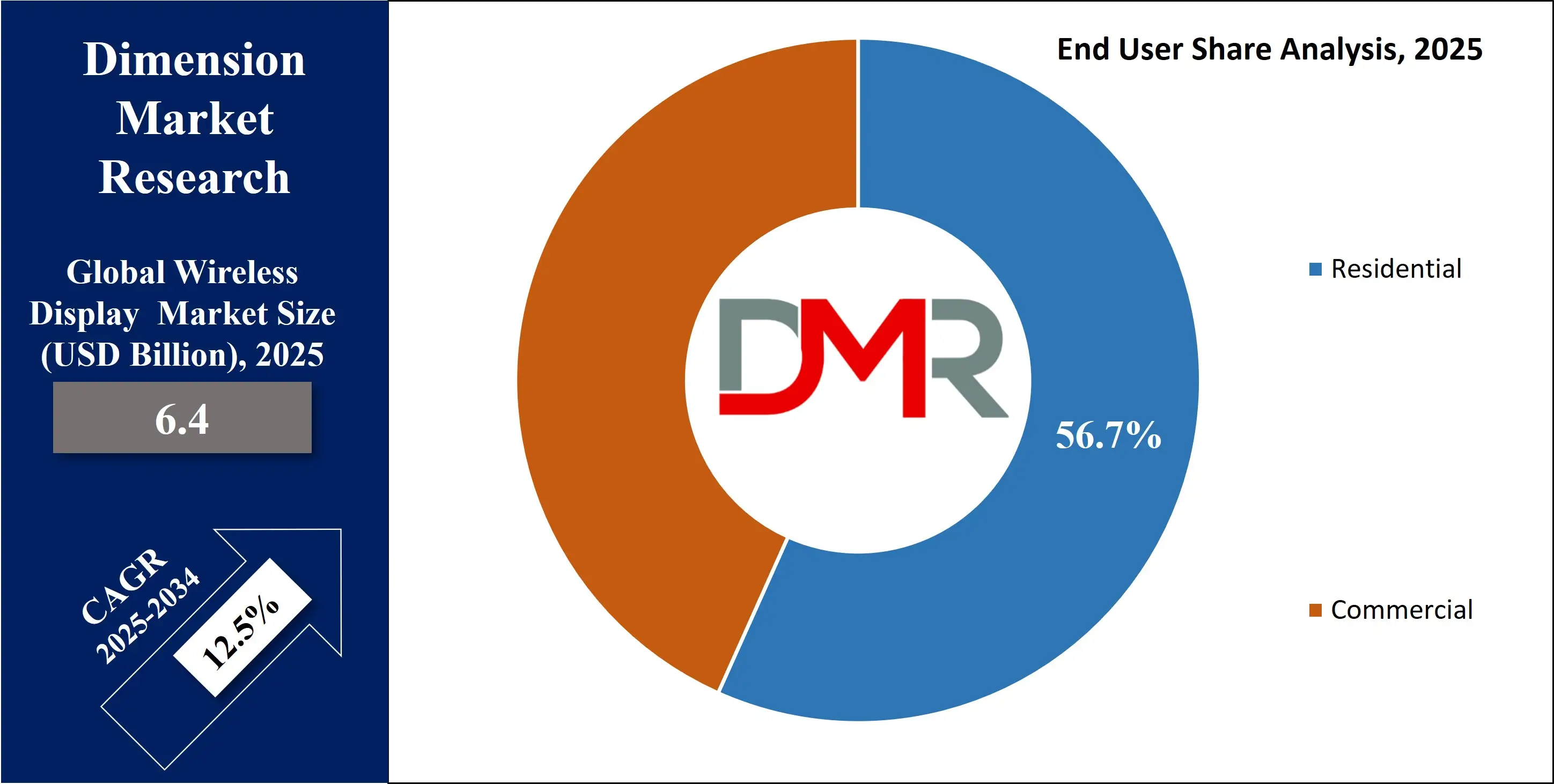
The rise of connected homes, online entertainment, and smart home ecosystems has further fueled this trend. Whether it’s casting a movie, sharing photos, or mirroring a phone screen, consumers appreciate the convenience and smooth experience wireless display offers. As digital content consumption continues to grow across all age groups, residential users are expected to remain a key contributor to market expansion, especially with the increasing affordability of smart and connected devices.
The commercial segment is showing significant growth over the forecast period, fueled by the increasing demand for wireless collaboration tools in offices, educational institutions, and public venues. Businesses are adopting wireless display technology to simplify meetings, enable fast presentations, and support hybrid work environments. It allows employees and clients to connect their devices to screens without needing technical help or physical connections, saving time and improving flexibility.
In classrooms, teachers use wireless displays to present lessons and involve students in interactive activities. Hotels, restaurants, and event spaces also use this technology to provide a seamless experience for guests and visitors. As the need for fast, flexible, and professional content sharing grows across industries, the commercial sector is set to become an even more important part of the wireless display market’s continued development.
The Wireless Display Market Report is segmented on the basis of the following:
By Offering
- Hardware
- Software & Services
By Technology
- AirPlay
- Miracast
- Google Cast
- Others
By End User
Regional Analysis
Leading Region in the Wireless Display Market
North America, leading in 2025 with a share of 34.4%, plays a major role in driving the growth of the wireless display market. The region benefits from a strong presence of leading tech companies, high digital adoption rates, and growing demand for smart devices across homes, offices, and schools. With more people working remotely and using connected devices, wireless display solutions are becoming essential for daily communication and entertainment.
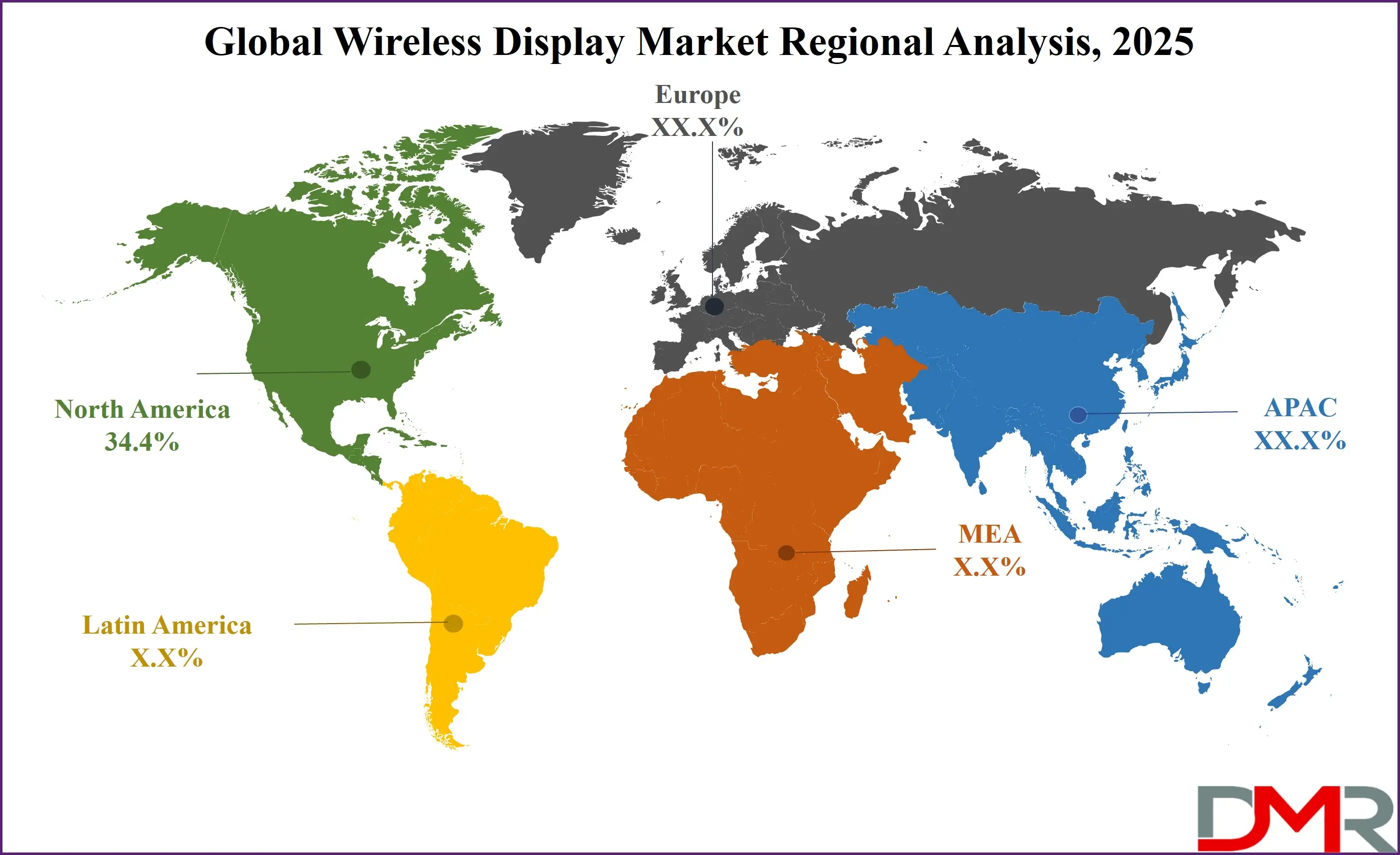
The region also sees widespread use of smart TVs, streaming platforms, and advanced display systems that support wireless connectivity. In addition, North America supports strong infrastructure for high-speed internet and wireless technologies like Wi-Fi 6, which help improve display performance. Educational institutions and healthcare providers are also increasing their use of wireless display tools to share content easily and efficiently. With ongoing investment in digital transformation and smart environments, North America is expected to maintain its leading position in the wireless display market through the rest of 2025 and beyond.
Fastest Growing Region in the Wireless Display Market
Asia Pacific is showing significant growth over the forecast period in the wireless display market due to rising demand for smart devices, growing internet access, and rapid digital transformation across developing countries. The region is experiencing a surge in wireless streaming, screen mirroring, and BYOD (Bring Your Own Device) trends in both education and business sectors.
Increasing use of smartphones, smart TVs, and tablets is also boosting interest in cable-free display solutions. With strong manufacturing capabilities and rising tech investments in countries like China, India, South Korea, and Japan, Asia Pacific is estimated to be one of the fastest-growing regions. Government support for digital learning and smart infrastructure further fuels market expansion.
By Region
North America
Europe
- Germany
- The U.K.
- France
- Italy
- Russia
- Spain
- Benelux
- Nordic
- Rest of Europe
Asia-Pacific
- China
- Japan
- South Korea
- India
- ANZ
- ASEAN
- Rest of Asia-Pacific
Latin America
- Brazil
- Mexico
- Argentina
- Colombia
- Rest of Latin America
Middle East & Africa
- Saudi Arabia
- UAE
- South Africa
- Israel
- Egypt
- Rest of MEA
Competitive Landscape
The wireless display market is becoming more competitive as more technology companies focus on offering smooth, fast, and user-friendly screen-sharing experiences. Many are working to improve compatibility across different devices like phones, tablets, TVs, and computers. New features such as high-definition streaming, low-latency performance, and multi-device support are being added to attract users. Both hardware makers and software developers are entering the space, creating a mix of smart devices and apps that can wirelessly project content.
The competition also comes from innovations in smart homes, remote work tools, and online learning systems. As demand rises, companies are pushing to offer more reliable, secure, and easy-to-use solutions that work across platforms, while keeping the setup process simple for everyday users.
Some of the prominent players in the global Wireless Display are
- Intel Corporation
- Microsoft Corporation
- Apple Inc.
- Google LLC
- Samsung Electronics
- LG Electronics
- Roku, Inc.
- Amazon.com, Inc.
- Sony Corporation
- Panasonic Corporation
- MediaTek Inc.
- Realtek Semiconductor Corp.
- Actiontec Electronics, Inc.
- Belkin International, Inc.
- Netgear, Inc.
- Dell Technologies Inc.
- Lenovo Group Limited
- HP Inc.
- AsusTek Computer Inc.
- Acer Inc.
- Other Key Players
Recent Developments
- In June 2025, the U.S. National Science Foundation announced up to USD 100 million in funding through the NSF VINES program to advance NextG wireless communication systems. In partnership with industry, government, and global allies, the initiative focuses on enhancing intelligent network systems across the user-edge-core-cloud landscape. According to NSF officials, the program aims to boost U.S. competitiveness in telecommunications and emerging NextG industries while preparing the workforce for future jobs. The investment supports innovations in areas like autonomous vehicles, smart manufacturing, and energy infrastructure.
- In May 2025, Microsoft announced that Miracast wireless projection will be added to Surface Hub 3 by the end of 2025, offering users greater flexibility in sharing and collaboration. Alongside this, support for Microsoft Edge is also being introduced, enhancing functionality through Microsoft Teams Rooms on Windows. These updates aim to make teamwork more seamless and productive. Since launching in December 2023 as the first all-in-one collaboration board with Teams Rooms, Surface Hub 3 has continued evolving through close collaboration between Surface and Teams engineering, driven by customer feedback.
- In May 2025, ZCast launched its latest innovations in wireless connectivity and collaboration. Headlining the launch is the new EZCast Omni Tetra, built for high-performance multi-screen display across up to four screens with a transmission range of up to 300 meters. It features a 2T2R dual-antenna setup, enabling stable signals across two independent channels, even through obstacles. With smart channel hopping, it actively avoids interference, making it perfect for professional, multi-display environments and live presentations.
- In January 2025, Samsung Electronics introduced Samsung Vision AI, bringing AI-powered, personalized screens designed to enrich daily life. The unveiling also featured the flagship Neo QLED 8K QN990F, updates to Lifestyle TVs, and future display innovations—highlighting Samsung’s vision of screens as smart, adaptable companions. SW Yong, President of Visual Display Business, shared that Samsung aims to transform TVs from passive devices into interactive, intelligent hubs that connect entertainment, personalization, and lifestyle for a seamless, simplified experience.
Report Details
| Report Characteristics |
| Market Size (2025) |
USD 6.4 Bn |
| Forecast Value (2034) |
USD 18.5 Bn |
| CAGR (2025–2034) |
12.5% |
| Historical Data |
2019 – 2024 |
| The US Market Size (2025) |
USD 1.9 Bn |
| Forecast Data |
2025 – 2033 |
| Base Year |
2024 |
| Estimate Year |
2025 |
| Report Coverage |
Market Revenue Estimation, Market Dynamics, Competitive Landscape, Growth Factors, etc. |
| Segments Covered |
By Offering (Hardware and Software & Services), By Technology (AirPlay, Miracast, Google Cast, and Others), By End User (Commercial and Residential) |
| Regional Coverage |
North America – US, Canada; Europe – Germany, UK, France, Russia, Spain, Italy, Benelux, Nordic, Rest of Europe; Asia-Pacific – China, Japan, South Korea, India, ANZ, ASEAN, Rest of APAC; Latin America – Brazil, Mexico, Argentina, Colombia, Rest of Latin America; Middle East & Africa – Saudi Arabia, UAE, South Africa, Turkey, Egypt, Israel, Rest of MEA |
| Prominent Players |
Intel Corporation, Microsoft Corporation, Apple Inc., Google LLC, Samsung Electronics, LG Electronics, Roku, Inc., Amazon.com, Inc., Sony Corporation, Panasonic Corporation, MediaTek Inc., Realtek Semiconductor Corp., Actiontec Electronics, Inc., Belkin International, Inc., Netgear, Inc., Dell Technologies Inc., Lenovo Group Limited, HP Inc., AsusTek Computer Inc., Acer Inc., and Other Key Players |
| Purchase Options |
We have three licenses to opt for: Single User License (Limited to 1 user), Multi-User License (Up to 5 Users), and Corporate Use License (Unlimited User) along with free report customization equivalent to 0 analyst working days, 3 analysts working days, and 5 analysts working days respectively. |
Frequently Asked Questions
The Global Wireless Display Market size is expected to reach a value of USD 6.4 billion in 2025 and is expected to reach USD 18.5 billion by the end of 2034.
North America is expected to have the largest market share in the Global Wireless Display Market, with a share of about 34.4% in 2025.
The Wireless Display Market in the US is expected to reach USD 1.9 billion in 2025.
Some of the major key players in the Global Wireless Display Market are Intel Corporation, Microsoft Corporation, Apple Inc., , and others
The market is growing at a CAGR of 12.5 percent over the forecasted period.